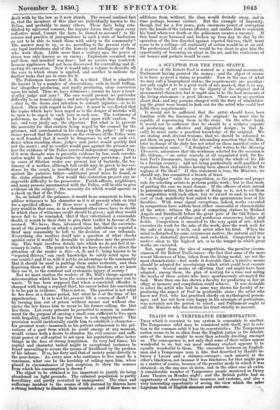A SCULPTOR FOR THE PFY.L STATUE.
A STATUE of Sir Robert Peel is wanted as a national monument, Parliament having granted the money ; and the object of course is to have as good a statue as possible. Now in the ease of what we may call a biographical statue, the requirements are peculiar : not only ought it to be a good work of art, marked, that is to say, by the traits of art suited to the dignity of the original and of monumental character, but it ought also to be the best memento of the living statesman—a good likeness. There can be no question about that; and any persons charged with the duty of administer- ing the grant were bound to look out for the artist who could best fulfil these requirements. It would not be sufficient that the artist should have been familiar with the lineaments of the original : he must also be capable of reproducing them in the stone. On the other hand, it would not be sufficient that he should be a sculptor capable of producing an effective and dignified design ; to that fa- culty he must unite a practical knowledge of the original. We are stating such obvious truisms, that we should be ashamed to put them on paper, but for the astounding assertion that the Min- ister in charge of the duty has not acted on these manifest rules of the commonest sense. "A Sculptor," who writes to the Morning Chronicle, announces that the workman selected for the occasion is Mr. Gibson,—" an artist scarcely at all acquainted with Sir Ro- bert Peel's lineaments, having spent nearly the whole of his life in a foreign country ; and not being particularly well qualified to reproduce them, his studies having been almost exclusively in the regions of the ideal." If this statement is true, the Minister, we should say, has committed a breach of trust. " A Sculptor" calls for competition, as the popular and proper rule for selecting artists to perform public work ;_ but to that mode of putting the case we must demur. If the officers of state intend to patronize artists, the best mode of doing so is, not to set them in competition with each other, but to award to each in turn the sort of task manifestly best suited to the spontaneous bent of his faculties. With some signal exceptions, indeed, works executed in competition have seldom been either successful or characteristic of the artist : witness the pair of competing statues by Michael Angelo and Bandinelli before the great gate of the Old13alace at Florence,—a pair of sublime and ponderous scarecrows, bulky and feeble. Competition is unsuited to the very spirit of art; which executes its work for the sake of the work, does the work well for the sake of doing it well, each artist after his kind. When the mind is disturbed by some extraneous motive, the natural and true motive is distorted, perverted, and enfeebled. Competition is a motive alien to the perverted,
art, or to the temper in which great works are executed.
But, apart from the idea of competition, the peculiar circum- stances of Sir Robert Peel's career—the fact that some of the more recent likenesses of him, taken from the living model, are not the most characteristic—had made it desirable that a tentative means should be adopted for ascertaining which artist could best execute the work. Several modes of effecting that end might have been adopted ; among them, the plan of waiting for a time and noting the works of those artists who have spontaneously attempted the task. More than one has shown a faculty for producing as fair an effigy as memory and compilation could achieve. It was desirable to select the artist who had in some way shown his faculty of re- producing the aspect of Peel in perdurable stone : the artist who knew not Peel, who has practised chiefly on mythological person- ages, and has not been very happy in his attempts at portraiture, was certainly not the person to select ; and Parliament ought to call the Minister who has broken his trust strictly to account.


























 Previous page
Previous page